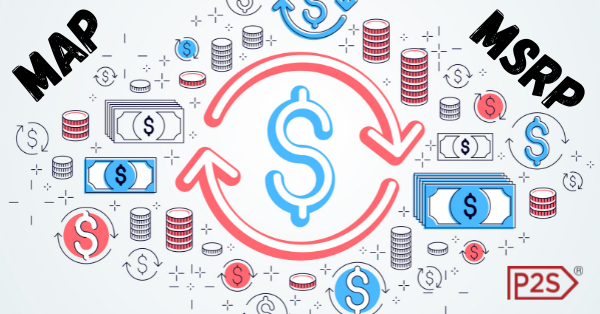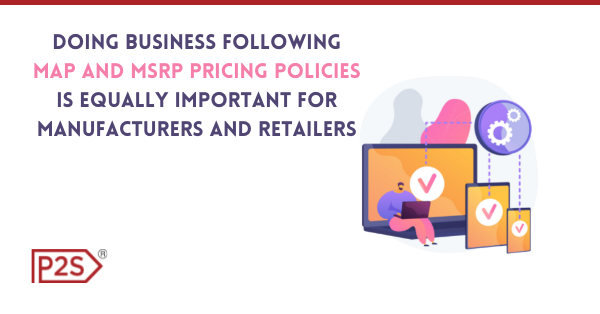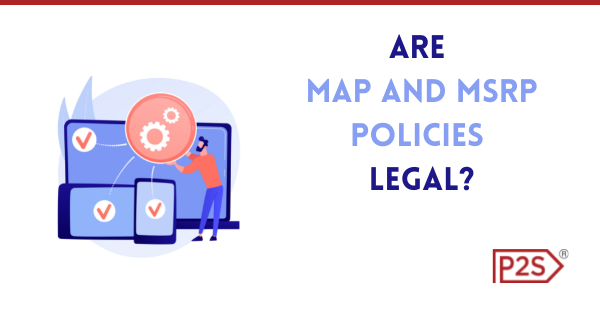
MAP & MSRP – The Importance of Detecting Violations
Reputation is the beliefs or opinions that are generally held about someone or something. To maintain a successful business, you should establish, continuously improve, and monitor your brand reputation. Your business reputation is crucial if you strive to be at the top of the market.
How is reputation even related to MSRP or MAP? And what do MSRP and MAP stand for? Read the article to the end to find the solution for the problem you may even do not know to have.

There are many online articles titled MSRP vs MAP, but I would focus on the equal importance of both terms when it comes to manufacturing and retailing. Two terms represent two different pricing goals, but ideally, they suppose to correlate and support each other to provide full insight into the market’s prices and pricing violations.
Let’s define these keywords. MAP stands for a minimum advertised price, while MSRP represents a manufacturer’s suggested retail price.
MAP & MSRP
MAP is the lowest advertised product price recommended by a manufacturer to the retailers of the products. The emphasis here is on the word “recommended” because MAP basically is a one-way policy. It is not even an official agreement. Anyhow, manufacturers are encouraged to establish their pricing policies even though distributors and retailers are not obligated to play by the rule.
Another significant point is that the MAP pricing strategy applies only to the advertising, not the actual selling. Meaning that a retailer can advertise a pair of shoes in accordance with the brand’s minimum advertised price policy, but it can sell it for less. The whole focus of MAP policy is how brand’s products are advertised and displayed in public by retailers.
The manufacturer’s suggested retail price policy (MSRP) is a one-way resolution as well. Manufacturers do not have the legal right to require distributors and retailers to sell their products at fixed prices, instead, they only suggest it.
By setting up MSRP, the manufacturer aims to standardize its products’ retail price on the market so the interests of every retailer and distributor can be protected. Ideally, the MSRP price covers all the selling costs (production costs, distribution costs, retailers markups, etc.), which supposedly guarantees that each of the parties will earn profit.
In theory, all participants in the sales process should benefit from the MSRP policy, while the MAP policy specifically seeks to protect the brand image. In any case, these two pricing strategies overlap and have common goals, to protect the brand reputation and prevent a price war while each party in the sales process profits. Therefore, the winning combination is when MAP and MSRP are correlated.
The Importance of Establishing MAP & MSRP Policies
It has already been said that these pricing strategies are deemed one-way policies, which might seem unnecessary to establish and follow to some of you. Yet, these policies could be beneficial in running a business, making the right decisions, and maintaining profitability and brand image. Brands, distributors, and retailers can be better off if their business is in accordance with MAP and MSRP pricing policies. Here is why.

From the Perspective of the Manufacturer
From a manufacturer’s perspective, the minimum advertised price and manufacturer’s suggested retail price were established to set boundaries in the market, as far as brand image is concerned. For example, let’s say a luxury fashion brand like Versace does not have these policies, and that you find Versace products, in this case, the La Medusa Mini Bag, which costs $1,350 at the official Versace online store, for $350 in Macy’s – what would you though?
Many questions would arise at the moment. Is this bad even real? What is wrong with this product? What happened to Versace? With the power of social media nowadays, this piece of info would flood the internet, and Versace’s reputation would be questioned while its products’ quality would be judged. Nobody wants this for their business. Of course, this is a banal and most likely never-to-happen example, but you got the idea. Now, even if the violation happens, how can your policies help your business?
Only if you have insight into the market prices, and if you monitor your retailers and competitors, you will be able to detect the MAP or MSRP violation. The most important thing that you should be aware of is a pricing chain reaction. This could be extremely dangerous for a manufacturer. It happens when one retailer lower a product price below MAP or MAPR prices and thus drags the average market price of that product down because the retailer’s competitors will aim to match the lowest price of the product to remain competitive and profitable.
A pricing chain reaction can be prevented if a manufacturer carefully monitors the market and detects the first MAP or MRSP violation that occurs before the chain reaction starts and penalize retailer who violated the policies.
From the perspective of the Retailer
Retailers can definitely go around these policies without violations. On the other hand, as already mentioned, they don’t have to sell products in accordance with these policies. Yes, selling products at a lower than anticipated price will bring them profit at that moment, but they risk losing long-term partners. When playing by rules and selling by respecting the agreement, retailers often get recognized and rewarded by manufacturers.
Many retailers monitor MAP and MSRP violations themselves as they monitor their competitor prices. Every business must be aware of the market conditions at any time. Violating these policies can be very risky due to the eventual price war and devaluation of the product. These wars would create a crisis for all parties, including retailers.
From the retailer’s perspective, these policies promote fair competition by allowing smaller retailers to stay competitive. Especially when the sellers who violated the policies are removed from the market by the manufacturer, all other retailers including small ones, can sell more.
Are these policies legal?
Every country has its legal regulations, so it would be good to learn more about the MAP and MSRP regulations in your country before establishing your policies. Anyhow, here are the simple rules to follow. Your safe course of action is to have a consistent policy applying across all the channels and to never discuss or negotiate policies’ details with any of them. If your retail or distribution partners contact you with questions regarding these policies, you should refer them to MAP and MSRP policies themselves. If your business is following these steps, your policies and their implementation will be perfectly legal.

What would be an ideal solution?
I keep saying make sure to monitor the prices of your competitors and detect violations in real-time, but how can you do that? If you are a brand that has a big product assortment and many retailers and distributors, it would be time-consuming and almost impossible to keep an eye on all of them. Therefore, manual monitoring is not a good choice for you, instead, think about an automated price monitoring tool that will do the job for you. The same applies to retailers who have a lot of competitors, get yourself a reliable tool.
Knowing that the eCommerce industry is fast-paced and that retailers often change prices several times a day, we can agree that price monitoring on the market is a full-time job. When using software for this activity, businesses are lowering the risk of error and utilizing time to focus on other business aspects. All they have to do it to wait for their software to alert them on eventual price changes and MAP or MSRP violations.
What do you get by using software such as Price2Spy?
Price2Spy is a price monitoring, comparison, and repricing tool, meant to help eCommerce professionals keep an eye on their competitors or retailers.
What can Price2Spy do when it comes to violating MAP and MSRP prices?
It can monitor violations in different markets and currencies. This tool’s mechanism alerts you as soon as a violation occurs. You will get the following indications: alert emails, product list, product section, price matrix report, pricing dashboard, the price below map report, and screenshots. It will be up to you only to analyze the data gathered and to wisely adjust your business to new market conditions.
Takeaway
Real-time monitoring and decision-making are important when it comes to violating MAP or MSRP policies. Both manufacturers and retailers should be aware of changes in market prices. This way, they will be able to adjust their business accordingly and remain at the top of the market. To maintain sales volume and profitability, do everything you can to protect your business reputation.
If you’d like to try out Price2Spy for free, start your trial today!



